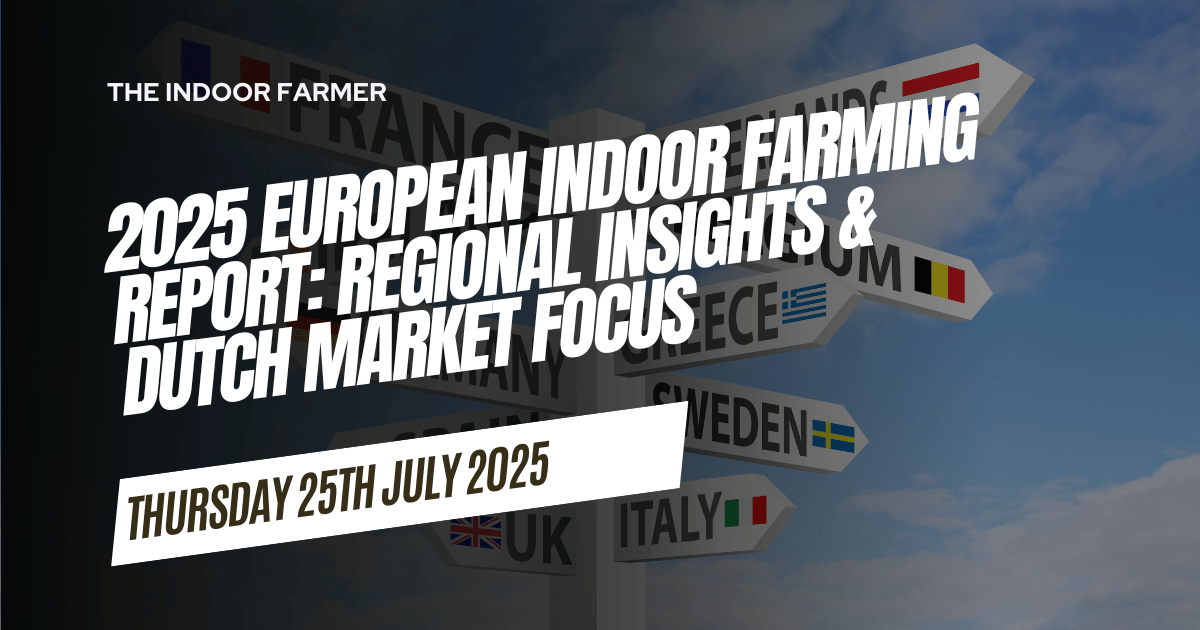- The Indoor Farmer
- Posts
- Looking Into The European Indoor Farming Landscape
Looking Into The European Indoor Farming Landscape
A comprehensive overview of Europe’s evolving indoor farming landscape, with regional insights, key crop trends, and a spotlight on the Netherlands’ global leadership in greenhouse horticulture.

Indoor farming is rapidly gaining momentum across Europe, with each country navigating its own mix of climatic, economic, and policy variables. Technological innovation, sustainability goals, and food security strategies are accelerating the adoption of Controlled Environment Agriculture (CEA) throughout the region.
The newly released 2025 European Indoor Farming Report, developed in partnership with Grow-tec, Würth Elektronik Group, and the AVF Summit powered by VertiFarm, provides a comprehensive regional breakdown and deep dive into one of the world’s most advanced indoor farming ecosystems: the Netherlands.
📥 Download the full report here.
🌍 Regional Trends: Fragmented Growth, Common Drivers
Europe’s indoor farming market is evolving in distinct ways depending on geography, policy, and market maturity. Yet several shared factors are shaping the overall momentum:
Technology Integration: CEA adoption is being driven by the implementation of automation, AI, energy-efficient LED lighting, and advanced fertigation systems—especially where return on investment (ROI) is clearly measurable.
Urbanization and Sustainability: Demand for locally grown, pesticide-free produce is growing. Governments and cities are increasingly integrating indoor farming into sustainability, circular economy, and food security strategies.
National Highlights:
Germany is focused on smart energy management and large-scale automation.
France emphasizes urban farming pilots and agri-tech innovation zones.
Spain leverages its greenhouse legacy, with water-conserving indoor models expanding.
Italy explores high-value specialty crops like herbs and baby greens.
The Netherlands maintains global leadership in greenhouse design and export capacity.
Key Crops: Tomatoes lead in volume and value, followed by leafy greens, strawberries, cucumbers, and peppers—reflecting both consumer demand and crop suitability for vertical and greenhouse systems.
Policy Context: CEA is increasingly being discussed in EU frameworks addressing food sovereignty, decarbonization, and rural development. Access to CAP funding, energy tax incentives, and innovation grants remains critical in most regions.
🇳🇱 Country Focus: The Netherlands
Despite its small size, the Netherlands continues to be a benchmark for greenhouse horticulture and indoor farming infrastructure. Its blend of agri-tech innovation, public-private collaboration, and export-oriented business models makes it a standout.
Industry Overview (2023 Data):
1,110 active greenhouse growers operate over 10,300 hectares, with more than 50% used for vegetable production.
Tomato yields now exceed 50 kg/m², highlighting the role of technology in maximizing output per square meter.
Consolidation continues: While the number of producers declines, larger players are expanding their footprint and vertical integration.
Global Supply Chain Role:
The country’s horticultural supply chain benefits from close cooperation between R&D institutions, manufacturers, and growers, ensuring fast deployment of innovations.
Technology Highlights:
LED lighting systems tuned for crop-specific growth stages
AI-based climate control and yield forecasting tools
Closed-loop water recycling and fertigation
Modular systems to support phased expansion and retrofitting
Public Support Mechanisms:
Subsidies and CAP co-financing support R&D, automation, and energy transitions.
Energy-intensive operations benefit from targeted tax relief schemes and sustainability funding—although long-term industry resilience may require reduced dependency on state support.
📈 Market Outlook: Growth with Guardrails
The European commercial greenhouse market is projected to reach USD 3.72 billion by 2030 (source: Mordor Intelligence). While CEA is scaling across the continent, challenges remain:
Energy Dependence: High energy costs, especially for heating and lighting, have become a key factor in project feasibility and financing models.
Labor Shifts: As manual labor declines, demand rises for technical roles in system management, maintenance, and data analysis.
Investor Expectations: Investors increasingly seek clear ROI pathways, operational efficiency, and energy-neutral infrastructure—particularly in newer vertical farming models.
Regional Resilience: As other regions accelerate domestic production, countries like the Netherlands may need to reassess reliance on export-led strategies.
🤝 Report Partners
This edition of the European Indoor Farming Report was developed in collaboration with:
Grow-tec – specialists in turnkey vertical farming systems
Würth Elektronik Group – leading provider of efficient horticultural lighting and power systems
AVF Summit powered by VertiFarm – a platform for global knowledge-sharing on vertical farming and next-gen food systems
The report includes insights from technology providers, growers, and policymakers across Europe, offering a nuanced picture of indoor farming today and its direction moving forward.
📥 Access the full report now.
Reply